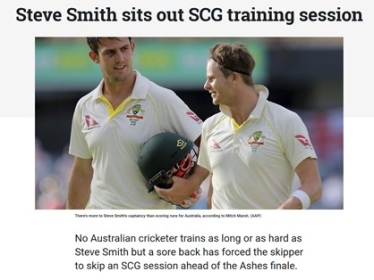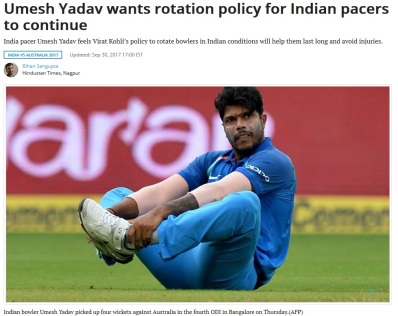Load Management, Roger Federer, Steve Smith and the Sweet Spot.
I was interested to read comments from Roger Federer about how he now trains and maintains his performance and then Ex Australian Cricket Captain Michael Clarke’s response to current captain Steve Smith training harder than most and to make sure he manages his loads in the future to avoid injury.

Roger Federer said after his Hopman Cup win:.
“I’ve played almost 1500 times so you have to be careful now. So it’s nice, I work part time now,” he said, the crowd lapping it up. “I work in the morning, I’m off in the afternoon or I do it the other way around.
Michael Clarke told the Nine Network:
“The key for him is going to be to sacrifice some training sessions so he can make sure he is still on the park as Australian captain,”.
“Because he loves hitting so many balls in the nets, he feels like that gives him the confidence to be able to walk out into the middle and play his natural game and play with that technique he has.
“I just feel over the next 12 months, he is going to have that down pat if he hasn’t already.”
There also is lots of discussion about injuries in tennis given the rush of issues confronting current top players. And in cricket numerous experts always question rotating bowlers.
Of course the discussion can go back to over specialization as kids in tennis and entering a High Performance phase before they have developed robustness through multilateral development. A 2011 Loyola University Medical Study by Dr. Neeru Jayanthi found that injured young athletes who play a single sport such as tennis spent much less time in free play and unorganized sports than uninjured athletes who play tennis and many other sports.
Steffan Jones is a former fast bowler and now a private coach in cricket. He believes there are a number of reasons why so many young English bowlers are breaking down including early specialisation which does not give children the valuable experience of different sports and physical challenges. “Bowlers are forced to specialise too early,” Jones wrote in a post on his LinkedIn page which he also shared with Cricbuzz. “External pressures, whether coach or parent driven stop them playing other sports at an age where they need to train the elastic qualities in the body.
And below we both can see how long it takes to mature and also how most sports on average have an average age > 25 at elite levels.

Pierre Paganini has been Federer’s fitness coach since he was a junior. It is interesting to read what Paganini has as a philosophy.
Roger Federer and Fitness Coach Pierre Paganini NY TIMES
Paganini and his prize pupils have focused above all on the long term. “Rog was always, even at age 20, interested in doing what he could to have a long career,” Paganini said.
That has meant not overplaying, building breaks into the season and listening intently to his body’s signals. It has meant reducing, if only marginally, the number of training sessions through the years. Paganini hopes the younger set, the #nextgen if you will, is taking notes.
“I think if we manage to motivate the young ones to give time to their bodies to recover from training before playing and then to give time to their bodies to recover from playing before training, this simple message can help us have fewer injuries in the future,” Paganini said.
And below is a quote from Paganini that shows he has data or information or just knows that Federer still has the necessary athletic qualities.

So before I talk about cricket it is important to talk about the “Sweet Spot” in loads popularized by Tim Gabbett’s research. My take on this is that for every individual there is an optimal training stimulus and for this individual this “Sweet Spot” changes at different stages of a career. So if an athlete is robust and bulletproof from an ideal development, the concept of training harder and smarter works. Where this gets tough to control is in academies and young athletes because the “Sweet Spot” changes rapidly for every individual. Almost where art meets science. And as athletes mature through their 20’s this changes all the time given training priorities and just being better at their sport. Also as athletes mature they are more powerful so put more stress on their body.

So one would assume that Steve Smith is 28 so at his physical peak and thus can tolerate big loads. What Michael Clarke is pointing to is that if Smith squeezes the Sweet Spot Graph on an upward curve into the ‘pink” then he may have issues. So for Smith, he may be in the sweet spot right now but next year on the back of this test, one dayers, Indian club commitments and other competitions he may have to re-evaluate his “Sweet Spot”.

Glenn McGrath entered the discussion on rotating bowlers.
https://www.sbs.com.au/news/rotation-policy-dead-and-buried-mcgrath
But despite the physical toll their gruelling workloads have taken, McGrath believes emphatically that the days of rotating the pace attack are over.
“If you asked both of those guys, they would definitely say no (to having a rest),” McGrath said on Sunday.
Yet what is interesting to read is how Mitchell Starc and Josh Hazlewood missed chunks of the recent tour to the sub continent in preparation for Ashes and both Starc and Hazlewood have been explosive and pivotal along with Smith in winning the Ashes.
And in 2013 one can also see that Starc missed large blocks with injury.
Sep 9, 2013: Australia bowler Mitchell Starc is set to miss the Ashes in Australia later this year because of a back injury. … Starc, 23, has an early stage stress fracture of the lower back and Cricket Australia says he is “expected to be unavailable for a prolonged period”
The other interesting subjective notion is that some players who bowl year in year out without rotation may be durable and robust but lack intensity.
And then we read press about the Rotations and Indian cricketers. Winners are grinners.

So right from when puberty is almost over to when an athlete retires there exists a “SWEET SPOT” in training to maximize performance and develop robustness. This is totally individual and so when past players and experts talk generalities about how they bowled day in and day out, just do some research about the athlete they are pointing to and also how they were developed..
What is important is that young athletes are developed carefully and exposed to a systematic and progressive increase in loads after puberty and this is individually aligned with maturation.
Once mature it is critical that an athlete and coach knows what training stimulus, loads and competition program will maximize performance and minimize risk of injury. And this individualized prescription always needs to be re-evaluated.
And it is better to be proactive than reactive.